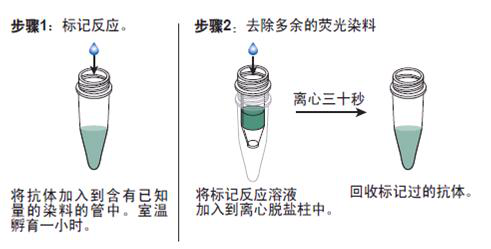
|

| 产地 | 进口、国产 |
| 品牌 | 上海莼试 |
| 保存条件 | Store at -20 °C |
| 货号 | CS10526 |
| 应用范围 | WB=1:100-500 ELISA=1:500-1000 IHC-P=1:100-500 IHC-F=1:100-500 IF=1:50-200 |
| CAS编号 | |
| 抗体名 | Anti-PSMA7/Proteasome 20S alpha 7 |
| 克隆性 | |
| 靶点 | 详见说明书 |
| 适应物种 | 详见说明书 |
| 形态 | 详见说明书 |
| 宿主 | 详见说明书 |
| 亚型 | IgG |
| 标识物 | 详见说明书 |
| 浓度 | 1mg/1ml% |
| 免疫原 | KLH conjugated synthetic peptide derived from human Proteasome 20S alpha 7 |
产品订购信息:
英文名称 Anti-PSMA7/Proteasome 20S alpha 7
中文名称 蛋白酶体PSMα7抗体规格
别 名 C6 antibody HSPC; Proteasome (prosome macropain) subunit alpha type 7; Proteasome alpha 7 subunit; Proteasome subunit alpha 4; Proteasome subunit alpha type 7; Proteasome subunit alpha type-7; Proteasome subunit RC6 1; Proteasome subunit RC6-1; Proteasome subunit XAPC7; PSA7_HUMAN; PSMA7; RC6 1; XAPC7.


浓 度 1mg/1ml
规 格 0.2ml/200μg
抗体来源 Rabbit
克隆类型 polyclonal
交叉反应 Human, Mouse, Rat, Dog, Pig, Cow, Horse, Sheep
产品类型 一抗
研究领域 细胞生物 发育生物学 干细胞 细胞周期蛋白 细胞分化 细胞类型标志物
蛋白分子量 predicted molecular weight: 28kDa
性 状 Lyophilized or Liquid
免 疫 原 KLH conjugated synthetic peptide derived from human Proteasome 20S alpha 7
亚 型 IgG
纯化方法 affinity purified by Protein A
储 存 液 Preservative: 15mM Sodium Azide, Constituents: 1% BSA, 0.01M PBS, pH 7.4
蛋白酶体PSMα7抗体规格 产品应用 WB=1:100-500 ELISA=1:500-1000 IHC-P=1:100-500 IHC-F=1:100-500 IF=1:50-200
(石蜡切片需做抗原修复)
not yet tested in other applications.
optimal dilutions/concentrations should be determined by the end user.
保存条件 Store at -20 °C for one year. Avoid repeated freeze/thaw cycles. The lyophilized antibody is stable at room temperature for at least one month and for greater than a year when kept at -20°C. When reconstituted in sterile pH 7.4 0.01M PBS or diluent of antibody the antibody is stable for at least two weeks at 2-4 °C.
Important Note This product as supplied is intended for research use only, not for use in human, therapeutic or diagnostic applications.
产品介绍 The proteasome is a multicatalytic proteinase complex which is characterized by its ability to cleave peptides with Arg, Phe, Tyr, Leu, and Glu adjacent to the leaving group at neutral or slightly basic pH. The proteasome has an ATP-dependent proteolytic activity. Plays an important role in the regulation of cell proliferation or cell cycle control, transcriptional regulation, immune and stress response, cell differentiation, and apoptosis. Interacts with some important proteins involved in transcription factor regulation, cell cycle transition, viral replication and even tumor initiation and progression. Inhibits the transactivation function of HIF-1A under both normoxic and hypoxia-mimicking conditions. The interaction with EMAP2 increases the proteasome-mediated HIF-1A degradation under the hypoxic conditions. Plays a role in hepatitis C virus internal ribosome entry site-mediated translation. Mediates nuclear translocation of the androgen receptor (AR) and thereby enhances androgen-mediated transactivation. Promotes MAVS degradation and thereby negatively regulates MAVS-mediated innate immune response.
Function : The proteasome is a multicatalytic proteinase complex which is characterized by its ability to cleave peptides with Arg, Phe, Tyr, Leu, and Glu adjacent to the leaving group at neutral or slightly basic pH. The proteasome has an ATP-dependent proteolytic activity. Plays an important role in the regulation of cell proliferation or cell cycle control, transcriptional regulation, immune and stress response, cell differentiation, and apoptosis. Interacts with some important proteins involved in transcription factor regulation, cell cycle transition, viral replication and even tumor initiation and progression. Inhibits the transactivation function of HIF-1A under both normoxic and hypoxia-mimicking conditions. The interaction with EMAP2 increases the proteasome-mediated HIF-1A degradation under the hypoxic conditions. Plays a role in hepatitis C virus internal ribosome entry site-mediated translation. Mediates nuclear translocation of the androgen receptor (AR) and thereby enhances androgen-mediated transactivation. Promotes MAVS degradation and thereby negatively regulates MAVS-mediated innate immune response.
Subunit : The 26S proteasome consists of a 20S proteasome core and two 19S regulatory subunits. The 20S proteasome core is composed of 28 subunits that are arranged in four stacked rings, resulting in a barrel-shaped structure. The two end rings are each formed by seven alpha subunits, and the two central rings are each formed by seven beta subunits. The catalytic chamber with the active sites is on the inside of the barrel. PSMA7 interacts directly with the PSMG1-PSMG2 heterodimer which promotes 20S proteasome assembly. Interacts with -1 TAT protein. Interacts with hepatitis B virus X protein (HBX). Interacts with HIF1A. Interacts with RAB7A. Interacts with PARK2. Interacts with ABL1 and ABL2. Interacts with EMAP2. Interacts with MAVS.
Subcellular Location : Cytoplasm. Nucleus.
Similarity : Belongs to the peptidase T1A family.
Database links : UniProtKB/Swiss-Prot: O14818.1

Anti-CMKLR1/CHEMR23/FITC 荧光素标记趋化样因子受体1抗体IgGMulti-class antibodies规格: 0.2ml
Anti-phospho-JAK2(Tyr221) /FITC 荧光素标记磷酸化蛋白酪氨酸激酶JAK-2抗体IgGMulti-class antibodies规格: 0.2ml
Rhesus antibody Rh CCDC67 卷曲螺旋结构域蛋白67抗体 规格 0.2ml
HLA-DR(human leukoyte Antigen DR) HLA-DR抗原 0.5mg
HOMER2 英文名称: HOMER2抗体 0.2ml
Rhesus antibody Rh SNF5 转录调控激活蛋白SNF5抗体 规格 0.2ml
Anti-phospho-JAK2(Tyr221) /FITC 荧光素标记磷酸化蛋白酪氨酸激酶JAK-2抗体IgGMulti-class antibodies规格: 0.2ml
FSP(Human Fibroblast surface protein) ELISA Kit 人纤维母细胞表面抗原Multi-class antibodies规格: 48T
Anti-PKA 蛋白激酶A抗体Multi-class antibodies规格: 0.2ml
Rhesus antibody Rh HIPK2 Fas相互作用蛋白激酶2抗体 规格 0.2ml
PABA(Mouse para-aminobenzoic acid) ELISA Kit 小鼠对基苯 96T
PSCD1 英文名称: 胞粘蛋白1抗体抗体 0.1ml
phospho-CREM (Ser271 +Ser 274) 英文名称: 磷酸化环磷酸腺苷反应元件调节蛋白抗体 0.1ml
Anti-PKA 蛋白激酶A抗体Multi-class antibodies规格: 0.2ml
UU-Ab(Human Ureaplasma urealyticum antibody) ELISA Kit 人解脲脲原体抗体Multi-class antibodies规格: 48T
Anti-MAdCAM-1 粘膜定居因子抗体Multi-class antibodies规格: 0.2ml
Rhesus antibody Rh Keratocan 细胞角膜蛋白多糖抗体 规格 0.2ml
OT/BGP ELISA Kit 大鼠骨钙素/骨谷酸蛋白 96T
phospho-PTK9 (Ty*1) 英文名称: 磷酸化蛋白酪酸激酶9抗体 0.1ml
Phospho-CHK2 (ser19) 英文名称: 磷酸化细胞周期检测点激酶2抗体 0.1ml
Anti-MAdCAM-1 粘膜定居因子抗体Multi-class antibodies规格: 0.2ml
CL-0460U14-GFP(小鼠子细胞)5×106cells/瓶×2
AACS Others Human 人 AACS / Acetoacetyl-CoA 杆状病毒-昆虫细胞裂解液 (阳性对照)
人颅骨造骨细胞RNAHCO miRNA5 μg
HL-60细胞,原髓细胞 人非小细胞细胞,NCI-H23细胞 MSC, 小鼠雪旺细胞
豚鼠胚胎细胞;104C1
CD226 Others Mouse 小鼠 DNAM-1 / CD226 人细胞裂解液 (阳性对照)
CL-0459U14(小鼠子细胞)5×106cells/瓶×2
CN3 Others Mouse 小鼠 Coactin 3 / CN3 人细胞裂解液 (阳性对照)
大鼠晶状体上皮细胞完全培养基 100mL
EB (NBL-4)牛胚气管细胞 EB (NBL-4) of bovine embryo acheal cells MEM培养基(GIBCO)+10%FBS
IL36G Protein Mouse 重组小鼠 IL36G / IL1F9 蛋白 (His 标签)
NCI-H446(人小细胞细胞) 5×106cells/瓶×2 HeLa(细胞)
蛋白酶体PSMα7抗体规格 小鼠骨髓间充质肝细胞(MMSC-bm)(5×105)
人虹膜色素上皮细胞cDNAHIPEpiC cDNA
大鼠脑细胞;C6
杂交瘤(B类);Z1510C6D10F4G6 小鼠脉络膜细胞完全培养基 100mL
HAVSMC, 人主动脉平滑肌细胞 Human
EFNA1 Others Mouse 小鼠 EFNA1 / Ephrin-A1 人细胞裂解液 (阳性对照)

抗体的生物素化标记实验要点:
1. 蛋白酶体PSMα7抗体规格 如在反应混合液中有叠氮钠或游离氨基存在,会抑制标记反应。因此,蛋白质在反应前要对 0.1mol/L碳酸氢钠缓冲液或0.5mol/L硼酸缓冲液充分透析;
2.所用的NHSB及待生物素化蛋白质之间的分子比按蛋白质表面的ε-氨基的密度会有所不同,选择不当则影响标记的效率,应先用几个不同的分子比来筛选最适条件;
3.用NHSB量过量也是不利的,抗原的结合位点可能因此被封闭,导致抗体失活;
4.由于抗体的氨基不易接近可能造成生物素化不足,此时可加入去污剂如 Triton x-100, Tween20等;
5.当游离ε-氨基(赖氨酸残基的氨基)存在于抗体的抗原结合位点时,或位于酶的催化位点时,生物素化会降低或损伤抗体蛋白的结合力或活性;
6.生物素还可能与不同的功能基团,如羰基、氨基、巯基、异咪唑基及*基,也可与糖基共价结合;
7.交联反应后,应充分透析,否则,残余的生物素会对生物素化抗体与亲和素的结合产生竞争作用;
8.在细胞的荧光标记实验中,中和亲和素的本底低,但由于链霉亲和素含有少量正电荷,故对某些细胞可导致高本底。
抗体的鉴定:
1)蛋白酶体PSMα7抗体规格 抗体的效价鉴定:不管是用于诊断还是用于,制备抗体的目的都是要求较高效价。不同的抗原制备的抗体,要求的效价不一。鉴定效价的方法很多,包括有试管凝集反应,琼脂扩散试验,酶联免疫吸附试验等。常用的抗原所制备的抗体一般都有约成的鉴定效价的方法,以资比较。如制备抗抗体的效价,一般就采用琼脂扩散试验来鉴定。
2)抗体的特异性鉴定:抗体的特异性是指与相应抗原或近似抗原物质的识别能力。抗体的特异性高,它的识别能力就强。衡量特异性通常以交叉反应率来表示。交叉反应率可用竞争抑制试验测定。以不同浓度抗原和近似抗原分别做竞争抑制曲线,计算各自的结合率,求出各自在IC50时的浓度,并按公式计算交叉反应率。
如果所用抗原浓度IC50浓度为pg/管,而一些近似抗原物质的IC50浓度几乎是无穷大时,表示这一抗血清与其他抗原物质的交叉反应率近似为0,即该血清的特异性较好。
3)抗体亲和力:是指抗体和抗原结合的牢固程度。亲和力的高低是由抗原分子的大小,抗体分子的结合位点与抗原决定簇之间立体构型的合适度决定的。有助于维持抗原抗体复合物稳定的分子间力有氢键,疏水键,侧链相反电荷基因的库仑力,范德华力和空间斥力。亲和力常以亲和常数K表示,K的单位是L/mol。抗体亲和力的测定对抗体的筛选,确定抗体的用途,验证抗体的均一性等均有重要意义。